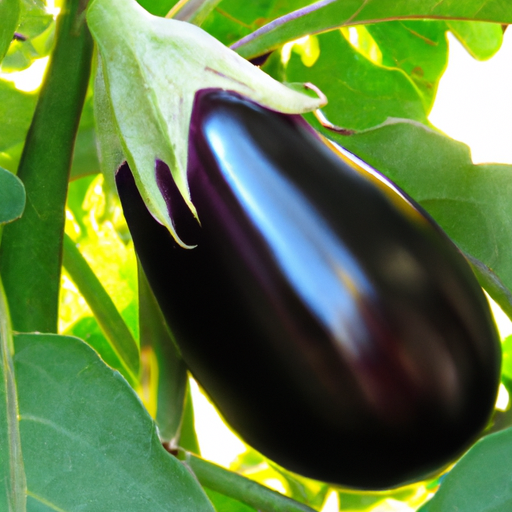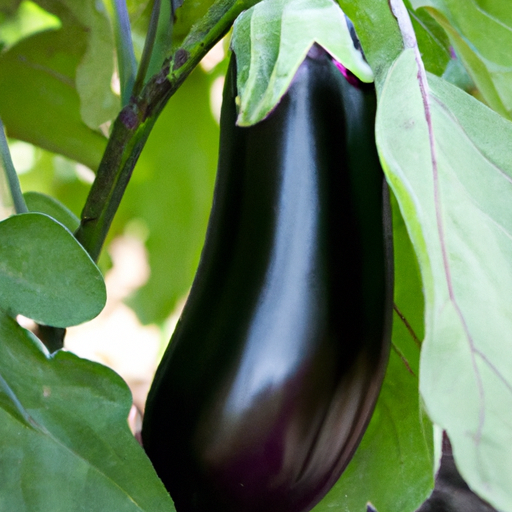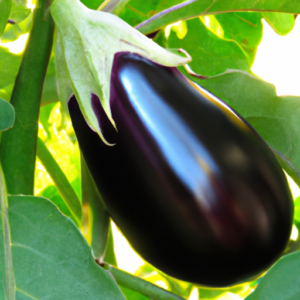Are you a fan of eggplant? If so, you might be interested in learning how to grow your own! In this article, we will provide you with all the essential tips and tricks on how to successfully grow eggplant in your own backyard. From choosing the right variety to planting and caring for your eggplant, we’ve got you covered. So, get ready to discover the secrets to a bountiful eggplant harvest!

Choosing the right variety
Consider your climate
When it comes to growing eggplant, one of the first things to consider is the climate in your area. Eggplants thrive in warm temperatures, so if you live in a region with a short growing season or cool temperatures, it may be a bit more challenging to grow this vegetable. However, there are certain eggplant varieties that are more suitable for cooler climates, such as the ‘Black Beauty’ or ‘Ping Tung Long’ varieties. On the other hand, if you live in a warm and sunny climate, you have a wide range of options to choose from.
Research different varieties
Before deciding on a particular eggplant variety, it is essential to do some research. There are numerous types and cultivars of eggplants available, each with its unique characteristics and requirements. Some common varieties include the classic ‘Black Beauty,’ which produces large and dark fruits, ‘Japanese’ eggplant which is long and slender, or ‘Fairy Tale’ with its small, striped fruits. By exploring different varieties, you can find the one that best suits your preferences and growing conditions.
Decide on the type of eggplant
Besides the choice of variety, another important decision to make is the type of eggplant you want to grow. Eggplants come in various shapes and sizes, and the selection of a specific type depends on your intended use. For instance, if you plan to use the eggplants for grilling or stuffing, larger varieties might be more suitable. On the other hand, if you prefer baby eggplants or plan to use them in stir-fries, smaller and more tender types would be a great option. Consider your culinary preferences and intended use when deciding on the type of eggplant to grow.
Preparing the soil
Test the soil
Before planting your eggplant seeds or seedlings, it is crucial to test the soil. A soil test will help you determine its pH level and nutrient composition. Eggplants prefer a slightly acidic to neutral soil pH, ideally ranging from 5.5 to 7.0. If your soil test reveals that the pH is outside this range, you can adjust it by adding amendments or using fertilizers designed to raise or lower the pH. Testing the soil ensures that you provide the optimal conditions for your eggplants to thrive.
Amend the soil
Once you have tested the soil and determined its pH level, you may need to amend it with additional nutrients. Eggplants are heavy feeders and require a soil rich in organic matter. Adding compost, well-rotted manure, or other organic amendments can improve the soil’s fertility and structure. These organic additions also enhance the soil’s ability to retain moisture and nutrients, which is especially important for the healthy growth of eggplants.
Add organic matter
In addition to amending the soil, incorporating organic matter is highly beneficial for eggplant cultivation. Organic matter, such as compost or aged manure, improves soil structure, increases water retention, promotes nutrient availability, and encourages beneficial microbial activity. Spread a layer of organic matter on the soil surface and work it into the top few inches using a garden fork or a tiller. This will help create a favorable environment for the roots of your eggplant plants.
Starting from seeds
Indoor sowing
Growing eggplants from seeds is a cost-effective way to start your plants. Indoor sowing provides the opportunity to control the environment and ensure optimal conditions for germination. Start the seeds indoors, approximately eight to ten weeks before the last expected frost. Sow the seeds in seed-starting trays or small pots, filled with a sterile seed-starting mix. Ensure the soil remains consistently moist but not soggy. Place the containers in a warm location and provide adequate sunlight or use grow lights to promote strong and healthy seedlings.
Outdoor sowing
If you live in a region with a long growing season and mild temperatures, you can directly sow eggplant seeds into the garden. Wait until the soil has warmed up and there is no longer a risk of frost. Prepare the garden bed by loosening the soil and removing any weeds or debris. Sow the eggplant seeds about ¼ to ½ inch deep, spacing them according to the specific variety’s recommendations. Water the soil gently after sowing, making sure to keep it consistently damp until the seeds germinate.
Transplanting seedlings
Whether you started your eggplants from seeds indoors or purchased seedlings from a nursery, at some point, they will need to be transplanted into the garden. Transplanting is typically done when the danger of frost has passed and the soil has warmed up. Before moving the seedlings, ensure they have developed a good root system and are well-established. Dig a hole in the prepared garden bed, making sure it is slightly larger than the root ball of the seedling. Gently remove the seedling from its container and place it into the hole at the same depth it was growing before. Fill the hole with soil and firm it gently around the base of the plant. Water thoroughly after transplanting to help the seedlings establish themselves in their new location.

Caring for the plants
Watering
Proper watering is crucial for the healthy growth of eggplant plants. Eggplants prefer consistent soil moisture, but they do not tolerate soggy or waterlogged conditions. Water the plants deeply, providing around 1 to 1.5 inches of water per week. However, always check the soil moisture before watering to ensure you are not overwatering. Stick your finger about an inch into the soil – if it feels dry, it’s time to water. Additionally, applying a layer of mulch around the base of the plants can help retain soil moisture and reduce water evaporation.
Mulching
Mulching the soil around your eggplant plants offers numerous benefits. A layer of organic mulch, such as straw, grass clippings, or wood chips, helps to suppress weeds, conserve moisture, regulate soil temperature, and improve soil fertility as it breaks down over time. Apply mulch around the base of the plants, taking care not to place it directly against the stems. This will help maintain a stable growing environment and support the overall health of your eggplant plants.
Fertilizing
Eggplants are heavy feeders and require a steady supply of nutrients throughout the growing season. Prior to planting, incorporate organic matter into the soil to provide a nutrient-rich foundation. As the plants grow, you can continue to feed them with additional organic fertilizers or compost. Avoid using high nitrogen fertilizers, as this can result in excessive foliage growth at the expense of fruit production. Instead, opt for balanced fertilizers or ones specifically formulated for vegetables. Follow the package instructions for application rates and frequency, but generally, fertilizing once a month during the growing season is sufficient.
Supporting the plants
Providing stakes or cages
As eggplant plants mature, they can become heavy with fruits, causing them to lean or even break under their own weight. To prevent this, provide support for your eggplants by using stakes or cages. Stakes should be driven into the ground near the base of the plant, and the main stem should be tied to the stake using soft plant ties or twine. If you prefer cages, place them around the plant when it is still small and gently guide the stems through the openings as the plant grows. Proper support will ensure that your eggplants remain upright, reducing the risk of damage and maximizing fruit production.
Training the plants
Training your eggplants can help increase air circulation and sunlight exposure, which promotes healthier plants with better fruit production. Encourage the plants to grow in a vertical direction by gently tying the main stem to the stake or the cage. As side shoots emerge from the main stem, you can also train them in a similar manner. This method helps to prevent the plant from becoming too bushy and allows for better pest and disease management.
Pruning
Pruning is an optional but beneficial practice for eggplants. By removing some of the lower leaves and shoots, you create better airflow around the plant, reducing the risk of fungal diseases. Additionally, pruning can help redirect the plant’s energy towards fruit production rather than excessive foliage growth. Use clean and sharp pruning shears to remove the lower leaves or any damaged or diseased parts of the plant. However, be cautious not to over-prune, as this can lead to sunburned fruits or reduced overall productivity.
Dealing with pests and diseases
Identifying common pests
Like any garden plants, eggplants are susceptible to pests. Some common pests that may affect your eggplant plants include aphids, flea beetles, spider mites, and tomato hornworms. Aphids are small, sap-sucking insects that can cause distorted growth and the presence of sticky residue on the leaves. Flea beetles are small beetles that chew tiny holes in the leaves. Spider mites are too small to be seen with the naked eye but can leave stippled, yellowing leaves in their wake. Tomato hornworms are large caterpillars that can defoliate the plants if left unchecked. Regularly inspect your plants for signs of pest infestations to take prompt action.
Implementing organic pest control methods
When it comes to dealing with pests on your eggplant plants, it is best to opt for organic pest control methods. There are several strategies you can employ to minimize pest damage. One effective method is handpicking pests, such as tomato hornworms, and dropping them into a bucket of soapy water. You can also employ beneficial insects like ladybugs or lacewings, which feed on aphids and other soft-bodied pests. Applying organic insecticidal soaps or homemade garlic and chili sprays can also help deter insects. Regularly monitoring your plants and taking action at the first sign of pest infestation is key to preventing extensive damage.
Recognizing common diseases
Eggplants can also be vulnerable to various diseases, including fungal, bacterial, and viral infections. Some common diseases that can affect your plants are fusarium wilt, verticillium wilt, early blight, or powdery mildew. Fusarium wilt causes wilting of the plant, starting with the lower leaves, and can eventually lead to plant death. Verticillium wilt presents similar symptoms, but the wilting occurs more gradually. Early blight causes dark spots on the leaves, which can spread and lead to defoliation. Powdery mildew appears as a white, powdery coating on the leaves, affecting their photosynthesis ability. Regular monitoring and early detection are crucial for managing diseases effectively.
Treating eggplant diseases
If you suspect your eggplant plants are affected by a disease, it is best to take immediate action. Depending on the specific disease, treatment options may vary. Fungal diseases can often be prevented by avoiding overhead watering and ensuring good air circulation. If a fungal infection is already present, you can apply organic fungicides or use copper-based sprays to help control the spread. Bacterial diseases are challenging to treat, but removing infected plants or affected plant parts can help prevent further spread. Viral infections have no cure, so prevention through good sanitation practices and insect control is essential. Consider consulting with a local gardening expert or extension office for specific disease management and treatment recommendations.
Harvesting the eggplants
Knowing the right time to harvest
Harvesting your eggplants at the right time is crucial to ensure the best flavor and texture. Most eggplant varieties are ready to harvest when the fruits reach their mature size, have a glossy sheen, and are firm to the touch. Avoid waiting too long to harvest, as overripe eggplants can become bitter and develop tough skins. The ideal size for harvest varies depending on the specific variety, so refer to the seed packet or plant label for guidance. Additionally, regular harvesting encourages the plant to produce more fruits throughout the season.
Harvesting techniques
To harvest your eggplants, use a clean pair of garden shears or a sharp knife. Cut the fruit from the plant, leaving a short stem attached. Twisting or pulling the fruits can damage the plant and its roots. Handle the harvested eggplants with care to avoid bruising or damaging them. Place them in a basket or container, taking care not to stack them on top of each other. Harvesting in the early morning or late afternoon, when temperatures are cooler, can help preserve the quality of the fruits.
Storing and preserving
Storing fresh eggplants
To store fresh eggplants, it is essential to keep them in optimal conditions to maintain their quality and extend their shelf life. Store harvested eggplants in a cool and dry place, such as a root cellar or the refrigerator. If refrigerated, place them in the vegetable crisper drawer, away from fruits that produce ethylene, such as tomatoes or apples, as this can accelerate spoilage. Fresh eggplants can typically be stored for up to a week, but it is best to use them as soon as possible for the best flavor and texture.
Preserving eggplants
If you have a bountiful eggplant harvest and cannot consume them all before they spoil, consider preserving them for later use. One popular preservation method is freezing. To freeze eggplants, blanch them by briefly immersing them in boiling water and then transferring them to cold water to stop the cooking process. Slice or cube the blanched eggplants and pack them in freezer-safe containers or bags. Another preservation option is pickling. Slice the eggplants and soak them in a vinegar solution with seasonings of your choice. The pickled eggplants can be stored in sterilized jars in a cool, dark place.
Troubleshooting common problems
Yellowing leaves
Yellowing leaves on your eggplant plants can be an indication of various issues. It can be caused by overwatering, nutrient deficiencies, pests, diseases, or even environmental stress. To determine the cause, assess the overall health of the plant, inspect for pests or signs of diseases, and consider your watering and fertilizing practices. Adjusting these factors accordingly can help resolve yellowing leaves. In some cases, removing severely affected leaves or treating the specific issue, such as adjusting nutrient levels or applying organic pest control methods, may be necessary.
Blossom end rot
Blossom end rot is a common problem in eggplants and other fruiting vegetables. It appears as a sunken, brown or blackened area at the blossom end (opposite the stem) of the fruit. Blossom end rot is caused by a calcium deficiency resulting from inconsistent or inadequate watering, nutrient imbalances, or rapid growth. To prevent this issue, maintain consistent soil moisture by watering deeply and evenly, ensure proper nutrient levels by amending the soil, and avoid excessive nitrogen fertilization. Applying calcium supplements, such as powdered eggshells or agricultural lime, can also help mitigate blossom end rot.
Wilting plants
Wilting plants can be a result of various factors, including underwatering, overwatering, pest infestation, diseases, or root damage. To determine the cause of wilting, check the soil moisture, inspect the plants for pests or signs of diseases, and assess the root system for any damage. Adjusting watering practices, implementing organic pest control methods, or treating specific diseases accordingly can help revive the wilted plants. In severe cases, it may be necessary to remove and dispose of heavily infested or diseased plants to prevent further spread.
Tips for successful eggplant growth
Provide adequate sunlight
Eggplants thrive in full sun, so it is important to provide them with at least 6-8 hours of direct sunlight each day. Choose a location in your garden that receives ample sunlight and is sheltered from strong winds, if possible. Without sufficient sunlight, your eggplants may not grow as vigorously, and their fruit production can be significantly reduced.
Maintain proper spacing
When planting your eggplant seedlings or seeds, it is crucial to provide adequate spacing between each plant. Eggplants have a spreading growth habit and can become quite large as they mature. Leaving enough space between plants allows for proper air circulation, reduces the risk of disease, and ensures that each plant has enough room to grow and develop fully.
Regularly inspect the plants
Regularly inspecting your eggplant plants is crucial to catch any potential issues early on. Take the time to examine the leaves, stems, and fruit for signs of pests, diseases, nutrient deficiencies, or any other abnormalities. Early detection and prompt action can help prevent the spread of pests or diseases and minimize damage to your plants.
Practice crop rotation
To maintain the health of your eggplant plants and prevent the build-up of pests or diseases over time, it is advisable to practice crop rotation. Avoid planting eggplants or other related plants, such as tomatoes or peppers, in the same location each year. Rotate your crops by planting them in different areas of your garden or using a three-year rotation cycle. This practice helps break pest and disease cycles, reduces nutrient depletion, and promotes overall soil health.
By following these comprehensive steps and adopting the necessary care practices, you can successfully grow healthy and abundant eggplants in your own garden. Whether you are a beginner or an experienced gardener, the joy of harvesting your own homegrown eggplants will be a rewarding experience. So, choose the right variety, prepare the soil, start from seeds, care for the plants, support their growth, address any problems, and enjoy the bountiful harvest. Happy gardening!

